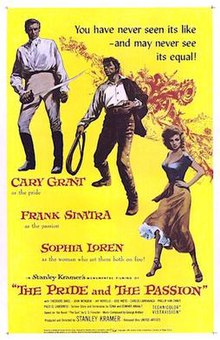| The Pride and the Passion | |
|---|---|
 Theatrical release poster | |
| Directed by | Stanley Kramer |
| Screenplay by | Edna Anhalt Edward Anhalt |
| Based on | The Gun 1933 novel by C.S. Forester |
| Produced by | Stanley Kramer |
| Starring | |
| Cinematography | Franz Planer |
| Edited by | Frederic Knudtson Ellsworth Hoagland |
| Music by | George Antheil |
Production company | |
| Distributed by | United Artists |
Release dates |
|
Running time | 132 minutes |
| Country | United States |
| Language | English |
| Budget | $3.7 million[1] |
| Box office | $3.5 million (US rentals)[2] |
The Pride and the Passion is a 1957 American Napoleonic-era war film in Technicolor and VistaVision from United Artists, produced and directed by Stanley Kramer, starring Cary Grant, Frank Sinatra, and Sophia Loren. The film co-stars Theodore Bikel and Jay Novello.
The film's storyline concerns a British Royal Navy artillery officer who has orders to retrieve a huge siege cannon from Spain and transport it by ship to British forces. First, however, the leader of the Spanish guerrillas wants to transport the weapon 1,000 km (620 mi) across Spain to help in the recapture of the city of Ávila from the occupying French before he releases it to the British. Most of the film deals with the hardships of transporting the large cannon to Ávila across rivers and over mountains, while also evading the occupying French forces that have been ordered to find it. A sub-plot concerns the struggle for the love of the Spanish woman Juana (Loren) by the two male protagonists.
The film story and screenplay by Edna Anhalt and Edward Anhalt are loosely based on the 1933 novel The Gun by C. S. Forester. Earl Felton contributed an uncredited screenplay re-write, George Antheil composed the music score, and Saul Bass designed the opening title sequence.
The film's music score was the last important work by George Antheil, once famous as the "bad boy of music" in the 1920s. It is the only one of Antheil's many film scores to have been preserved on a commercial soundtrack recording.
- ^ Tino Balio, United Artists: The Company That Changed the Film Industry, University of Wisconsin Press, 1987 p. 101
- ^ Top 20 Films of 1957 by Domestic Revenue